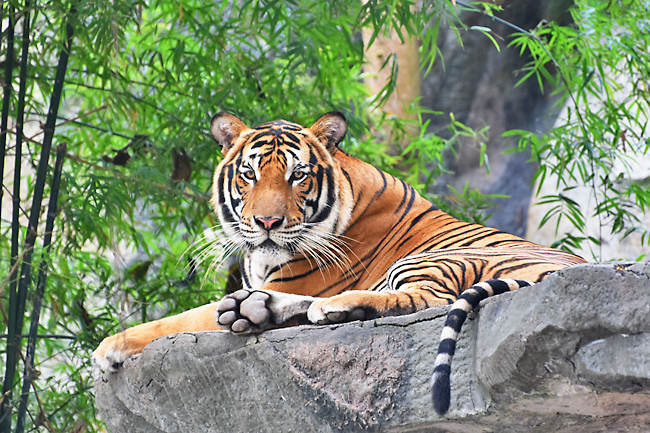Danial Norjidi
In conjunction with the 2022 Lunar New Year, Executive Director of the ASEAN Centre for Biodiversity (ACB) Dr Theresa Mundita S Lim in a recent statement urging everyone to take part in the shared responsibility of protecting tigers, their prey and habitats, while also lauding efforts of ASEAN member states.
In the statement, the executive director noted that the 2022 Lunar New Year, which started on February 1, marked new beginnings for many citizens of the ASEAN.
“The ACB joins the region in celebrating this holiday as we welcome the Year of the Tiger,” she said.
“Lunar traditions and celebrations welcoming the year of the tiger bear more significance for the ASEAN region, being home to three out of the six existing sub-species of tigers: the Indochinese Tiger, which has been recorded in Cambodia, Laos, Myanmar, Thailand, and Vietnam; the Sumatran Tiger in Indonesia; and the Malayan Tiger in Peninsular Malaysia and southern Thailand,” she said, “Tigers (panthera tigris), the largest member of the cat family (felidae), are mostly solitary and highly adaptable.
“They prey on large animals like deer, wild boar, and even elephant calves and require large contiguous areas approximately between 70 and 600 square kilometres to thrive.

“These powerful apex predators continue to be pivotal players in ensuring the health of our ecosystems, and consequently, the wellbeing of humanity.”
“Yet, throughout their range, wild tiger populations are declining due to various threats resulting from human activities. In Malaysia, the dwindling population of the Malayan Tigers, considered as one of the country’s iconic species, is a major concern,” continued Dr Lim, noting that based on the latest figures from the survey that the Malaysian government is conducting, fewer than 150 tigers remain in the wild.
The executive director shared that in Thailand, a group of 18 tigers has been recorded from June 2016 to February 2017 in the Dong Phyayen and Khao Yai forest complex, based on a survey conducted by the country’s Department of National Parks, Wildlife and Plant Conservation, Freeland Foundation, and Panthera Foundation.
Meanwhile, she said that in Myanmar, tigers have been rarely spotted in the region and have been considered “extirpated”, according to the country’s Sixth National Report to the Convention on Biological Diversity.
“We laud the efforts of the ASEAN member states (AMS) in addressing the decline of wild tigers and their prey,” said Dr Lim.
“The ACB is currently supporting transboundary efforts between Malaysia and Thailand in protecting the important tiger and elephant landscape at the border of these countries.”
She said in Malaysia, routine patrolling is supplemented by the all-year-round anti-snare programmes and the recently established National Tiger Conservation Task Force chaired by the Prime Minister.
Dr Lim also shared that in Indonesia, ex-situ wildlife conservation efforts have succeeded in breeding several endangered animals, including the Sumatran tiger (panthera tigris sumatrae).
“We congratulate the government of Malaysia and the Global Tiger Forum for successfully hosting the Fourth Asia Ministerial Conference on Tiger Conservation from January 19-21, 2022 and adopting the Kuala Lumpur Joint Statement on Tiger Conservation,” she said.
“These developments reflect the strong commitment of the tiger range states to protecting the region’s majestic felines.
“The ACB is ready to support further collaborations and dialogues to address the main threats to the tiger populations, including contributing to actions outlined in the Joint Statement,” affirmed Dr Lim.
She added, “Amid the challenges of biodiversity loss, we urge everyone to take part in the shared responsibility of protecting tigers, their prey, and their habitats. This endeavour can only be possible through stronger partnerships and effective strategies on the ground to address threats, such as wildlife trafficking and habitat loss.
“May the citizens of ASEAN draw inspiration from the magnificent wild tigers of our region in wielding the opportunities that the Lunar New Year has to offer,” added Dr Lim. “Just like how tigers are, may we be key figures in maintaining the harmony and balance in ecosystems, because #WeAreASEANBiodiversity.”
Established in 2005, the ACB is described as an intergovernmental organisation that facilitates cooperation and coordination among the 10 ASEAN member states and with regional organisations on the conservation and sustainable use of biological diversity and the fair and equitable sharing of benefits arising from the use of such natural treasures.
According to the ACB’s website, among the centre’s goals include to: facilitate coordination and cooperation on regional biodiversity conservation programmes; deliver capacity-building services; develop regional mechanisms to sustainably manage and protect biodiversity and ecosystems and strengthen ASEAN regional positions in negotiations and in compliance with relevant multilateral environmental agreements; impart and deliver to AMS the knowledge and tools on managing biodiversity; enhance the linkage between science and policy on biodiversity; promote multi-stakeholder and leadership awareness of the values of biodiversity and the actions they can take to conserve it; undertake resource generation and mobilisation measures for impact activities that will enhance biodiversity conservation in the region; and enhance ACB’s capacity and sustainability as a regional centre of excellence on biodiversity.






